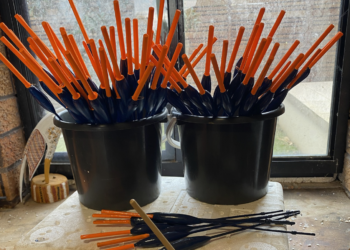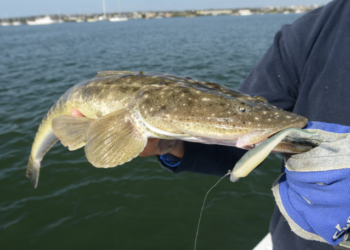IF I had to pick one particular style of lure fishing as the most effective way to catch bream, it would be crankbaiting. And to elaborate further, I’d say crankbaiting the shallows. If conditions are favourable, you can experience some champagne fishing within the shallow margins of an estuary. Cranking the flats is an active and productive way to fish but is often overlooked by many anglers.
Why Crankbaits?
Crankbaits, aka hard-bodied lures, are a great search bait, and you can cover an area quite quickly with a cast and crank approach. There are other lures out there that will work wonders on the flats, however, if you want fast results, then a shallow running crankbait with a round profile will typically serve you well. There are a plethora of varieties on the market in all manner of price ranges and colours, but the lures that transmit a wide wobble action are best. It doesn’t particularly matter if they float or suspend, as long as they create some disturbance when retrieved.
Lures that wobble hard will call fish in to investigate and if you’re fishing a large expanse of water, then you’ll need your lure to do all the work it can for you. Crankbaits that run to a depth of a metre and less are good (given that you are most likely to be fishing in water less than a metre deep), but don’t be deterred from running deep diving cranks over the flats either. Deep running lures will grub the bottom and stir up the silt, which can really turn fish on. If I’m fishing with a mate, one of us will run a deep while the other runs a shallow to see what’s most effective.
Fishing with crankbaits is an easy (and somewhat lazy) way to catch bream. You simply cast them across a likely area, and do nothing else but crank them back to the boat under a slow and constant retrieve. It doesn’t get any easier than slow-rolling a crankbait. These lures are generally quite heavy in weight (averaging 4 grams), which makes casting a pleasure. The beauty of this style of fishing is that the bream generally “climb onto” your lure without the need to strike and set the hooks, which is why I believe that crankbaiting is a great option if you’re just learning to pursue bream with lures. As you advance, you can experiment with your retrieve by incorporating a pause, or varying the speed. Regardless, slow and steady usually wins the race.
Proof in the pudding
Cranking the shallows is a proven method. As such, it’s constantly employed by Australia’s leading tournament anglers. If the host system of the tournament harbours a good range of sand flats, then most competitors will crank these flats early to obtain their bag of five bream. After boating their limit, they’ll then search for those all-important upgrades. Whether they persist on the flats or search elsewhere is irrelevant. The fact is the bream specialists know that the shallow flats will produce numbers of fish, which is why most switched-on tournament anglers will prospect the shallows to secure their bag early … leaving ample time to hunt down the tournament winning “big dogs”.
Early Start
Bream are one of those fantastic species that don’t require an early start for success. This said, I believe there’s one situation when an early start can prove advantageous. Bream can be wary feeders, particularly when feeding out of their comfort zone. When this is the case, the low-light conditions of early morning can have benefits. Most flats fish better with a breeze chopping the surface (which I’ll touch on later), however, most coastal trade winds rarely blow until later in the day. Calm and glassed out conditions can make it incredibly tough to fool flats bream, unless fishing during low light periods. There’s no better time to fish these conditions than early in the morning. The bream have generally patrolled the flat throughout the night, and are still willing to feed before the sun shows its full force. This is a great time for presenting crankbaits on the flats, as the bream are active and eager to eat. You’ll often encounter large bream as well.
Stealth Factor
Stealth may not always be required. There will be some cases when the bream don’t care that you’re on the flats with them. I’ve drifted onto bream that have had their noses down in the sand feeding and have only spooked the moment the boat cast a shadow across them. Seeing this time after time has led me to believe in a theory that has been invaluable to me over the years. Shadows and silhouettes are your worst enemy while fishing the flats. Positioning your boat in a way to allow you to present the lure between you and the sun is highly recommended. You’re basically staring into the sun as you’re fishing, however, there’s no chance of any shadow from yourself or your boat potentially spooking the fish. Worse than shadows are silhouettes. If the sun is behind you, the bream will see a large dark shape (you) that will almost certainly alarm it. Shadows may not cast all that far, however, a silhouette will be seen from quite a distance.
The other problem lies with prevailing wind. You typically want the wind behind you to aid casting distance and drift. This can become tricky if both the sun and wind are at your back. There are two ways that I combat this issue. I opt for a stiff rod and heavier lure in order to punch a cast into the breeze. This is my preferred option, as I believe a silhouette is far more detrimental than any benefits from increased cast distance, particularly when the water surface is chopped up with breeze. My second option is to fish with both sun and breeze at my back, select a longer rod, and use the wind to assist cast distance in hope of clearing any silhouette or shadow. This said, I will cast ahead of my drift at 45 degrees to my windward course, and target areas that may not be affected by a direct silhouette. As I mentioned before, stealth isn’t always critical, however, keeping a low profile can prove the difference on those days when the bream are wary.
Windy Rewards

There is no denying that the most productive time to prospect the flats is during breezy conditions.The primary catalyst for peak productivity during windy periods is due to the cover provided by the surface chop. Bream tend to drop their guard during these conditions; they’re also less likely to sense a drifting boat due to the surface commotion. Another explanation why windy days produce good flats fishing could be that prawns, crabs and soft-shelled clams are stirred from the sand due to wave activity. Baitfish also become vulnerable during choppy conditions.
A lot of the better bream anglers I know prefer to fish for bream in the afternoon, when those localised trade winds have well and truly kicked into gear. In most cases, these trade winds begin to puff between midday and three o’clock … in fact, “the 3 o’clock bite” is a common phrase heard among the breaming fraternity. The added advantage of an afternoon session is the fading light of late afternoon in conjunction with wind chop. Conditions like this are hard to beat. Most anglers will pack up during blustery conditions, but the experienced bream angler knows a strong bite period is on the cards. There is
a limit though … 20 to 30 knots of wind can be pretty uncomfortable to fish in!
Strike zones
Not all flats hold fish, and locating a likely flat can take a little time. When I’m on the search for a productive flat, I look for subtleties such as depth changes and bottom strata. Clean sand can look pretty but is often devoid of nutrients and therefore offers little in the way of food. Look for muddy or silty sands that “sparkle” with shell remnants and worm casings. The odd patch of seagrasses is good as well as are scattered shells and pebbles.
Open sand flats will fish well provided that there is a food source. The best way to identify a fertile flat is to look for fish digs. Craters and holes in the bottom strata are indicative of fish feeding activity. Nipper (saltwater or bass yabby) holes are also a sign of nutrient rich sand, and so too are stingrays sifting through the silt. These areas are usually found tucked away out of the main tidal flow. It’s worth prowling around during calm conditions, and searching for these areas. The most likely areas you’ll find active bream will be adjacent to a depth change. It doesn’t need to be much either, as long as it is rapid. These sudden depth changes provide the bream an ambush site when feeding on prawns and the like. Bream will also feed close to the shore, so it is worth venturing across the flat and casting toward the bank. You’ll often see the bow waves of feeding bream in these ultra-shallow regions.
Vision
Casting and cranking differs from “sight-casting” as you’re not constantly looking to identify isolated fish. It’s more about looking for aggregation sites and feeding zones. You’ll need a pair of polarised sunglasses, but not primarily for seeing fish. A good pair of polarised sunnies will help locate and identify those depth changes and varying sands colours. As mentioned before, it is these areas where most bream will aggregate. Copper, brown or rose based lenses are best for this style of fishing. Mirrored coatings will help reduce surface glare, and a good HD filter will provide clarity.
Light gets the bite
Go light to get the bite – have fun and let the fish run! This is something I tell newcomers to flats fishing. When fishing the flats, it’s rare that you’ll encounter nasty structure, so you can afford to permit your fish to peel off as much line as it needs. This theory allows you to use the lightest line possible, so most crankbait enthusiasts will run 1kg (2lb) fluorocarbon line straight through. The added bonus with fluorocarbon (apart from its near invisibility) is the stretch within the line. It’s uncommon to lose a fish hooked on fluoro. This is due to the line’s inherent elasticity. In fact, I don’t know of too many crankbaiting flats anglers who use braid these days due to its zero stretch qualities and associated issues such as pulled hooks. With light fluorocarbon line, you’ll need a soft bending rod. I prefer long rods, (7′ 6″ 1-2kg) as they provide cast distance, along with an element of control when a bream decides to seek refuge beneath your boat during the fight. Quality 1000-1500 sized spin reels with 2kg of smooth drag is all that’s required.
Because of this light approach, you’ll need to replace some of your lure’s standard trebles with ultra-fine light gauge hooks. These hooks should be sticky sharp when you touch them, so they penetrate the fish with minimal effort. There are some big bream in the shallows, however, cranking the flats is typically about the numbers, which are dominated by average sized fish. Nevertheless, cranking the flats is a lot of fun, which is exactly how it should be, right?




















